Elegant, Lesser Crested, West African Crested and Royal Terns – collectively known as the 'orange-billed terns' – are all possible vagrants to Britain and Ireland. But their very rarity and their similarity to each other make picking one out difficult. Add hybrids and Cayenne Tern into the mix and recognising any one of these species is even more challenging. Paul Dufour and Pierre-André Crochet provide all the in-depth information you need to identify these tricky terns if you're lucky enough to find one.
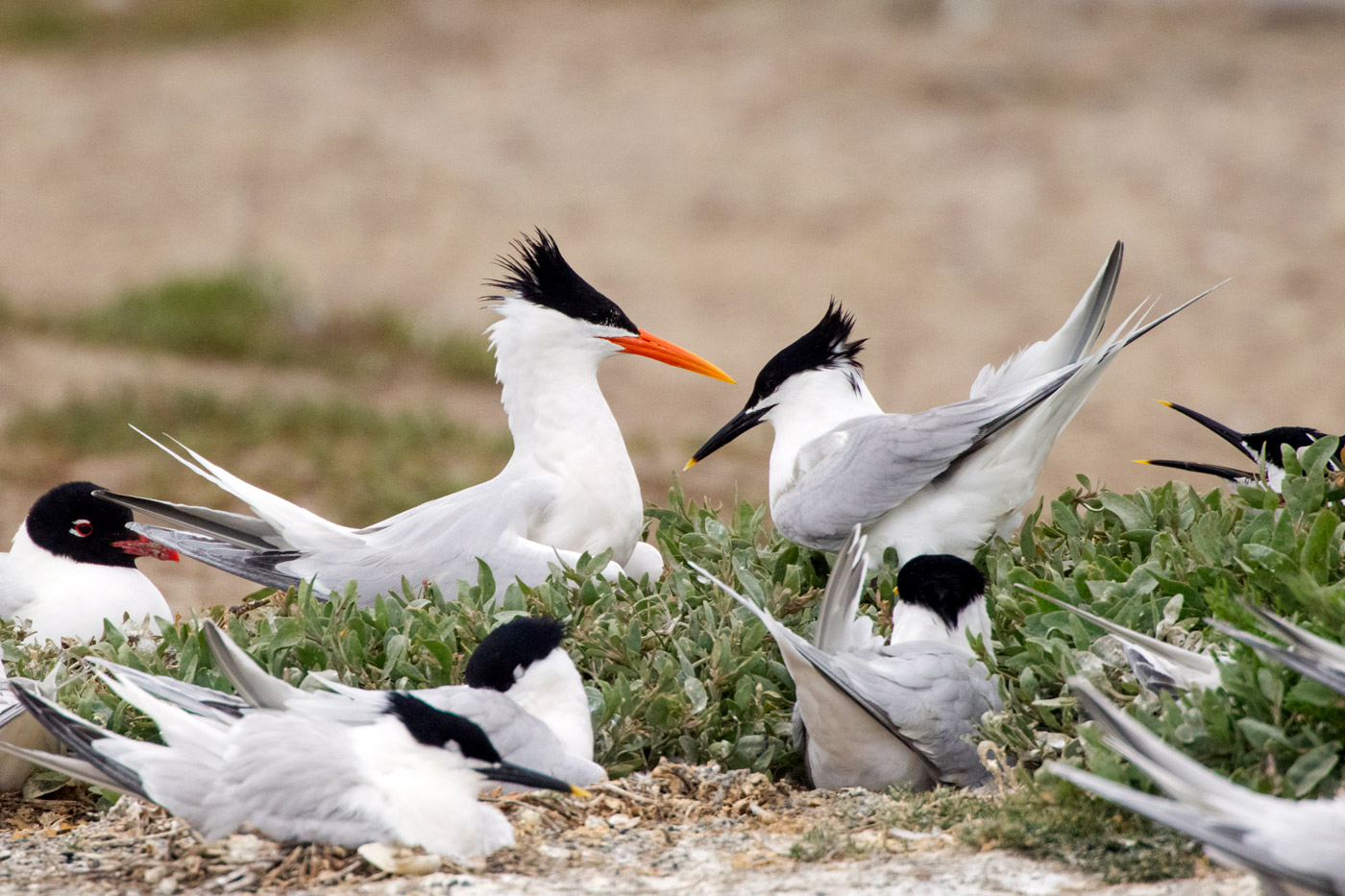
Adult Elegant Tern (Noirmoutier Island, France, 25 May 2015). With its reddish-orange bill, paling towards the tip, Elegant Tern rarely goes unnoticed in a colony of Sandwich Terns. The colour and shape of the bill stand out as important features in the identification of orange-billed terns, but these vary more in Elegant than is usually appreciated and some individuals do not differ from Lesser Crested Tern in that aspect. Elegant, however, shows a very similar mantle colour to Sandwich Tern, which is an important feature to check when confronted with a vagrant in Europe; in Lesser Crested, the mantle is typically darker than Sandwich. The often-quoted longer crest with shaggy nape is not always striking, but the white rump – a diagnostic feature to separate Elegant from Lesser Crested Tern – is clearly visible here (David Monticelli / www.agami.nl).
Terns are known to undertake some of the most spectacular migratory journeys in the animal kingdom. These movements make them more likely to stray and be observed far from their normal ranges.
Recent genetic research has recently redefined the boundaries between a group of species commonly referred to as the 'orange-billed' terns, of the genus Thalasseus. We discuss here the identification of species which have either already been observed in Britain or which could likely appear here.
Elegant Tern
This species breeds on the west coast of North America, from southern California to Baja California, Mexico, mainly on Isla Rasa in the Gulf of California, which hosts more than 90% of the world's breeding population. Outside the mating season, it is distributed along the Pacific coast of America as far south as Chile.
Slightly larger than Sandwich Tern, it has a long, dagger-shaped, orange bill (varying from yellowish-orange to reddish-orange), being deepest in colour at the base. In flight, the rump is white.
Occasionally occurring on the east coast of the USA, Elegant Tern was first observed in Europe in a Sandwich Tern colony in France in 1974. Since then, it has been seen almost annually in Europe, with about 20 individuals involved, many of which return to the same Sandwich Tern colonies for many years and have hybridised with the latter on several occasions. Since 2009, a minimum of eight Elegant Terns have been breeding near Valencia, Spain, either in mixed pairs with Sandwich Terns or as pure pairs, producing seven pure juveniles.
The identity of these birds has long been debated as it was suspected that they were hybrids with other orange-billed terns, as it seemed unlikely that several individuals of a species native to the Pacific would be present in the north-east Atlantic and Mediterranean areas. However, genetic analyses of samples from birds breeding in France and Spain have clarified their identity.
In Britain, the species has been observed on five occasions since 2002, the year of the first accepted record. That year three different individuals were seen, with one in 2005 and a ringed bird in 2017, the latter of which has regularly spent the summer in France since 2002. There are also six records from Ireland, the most recent of which was in September 2013.
Lesser Crested Tern
This Old-World tern has a wide distribution from North Africa to Oceania, including the Gulf of Arabia, northern Indian Ocean and South-East Asia from Sulawesi eastward. The closest populations to Britain breed in Libya, wintering along the coasts of northern and western Africa.
It is similar in size to Sandwich Tern and, in appearance, is a close match to Elegant Tern. However, the upperparts are generally darker than in the latter species and the bill tends to be straighter, paler yellowish-orange and more concolorous. Crucially, in flight, the rump is pale grey rather than white.
Rare in southern Europe, this species has been observed in Sandwich Tern colonies in Spain, France and Britain on several occasions. It was first recorded in Britain in 1982 and then annually until 1998. During these years, at least three birds were seen, including one that returned to the same Sandwich Tern colony on the Farne Islands, Northumberland, from 1984-1997, producing hybrid young in some years. Another was observed in East Anglia in summer 2005, but it hasn't been recorded since.
West African Crested Tern
This species breeds sporadically on the west coast of Africa from Mauritania to Guinea, sometimes further south. Outside the breeding period, it ranges from Morocco to Angola.
Superficially similar to Lesser Crested Tern, it is noticeably larger (between Lesser Crested and Caspian in size) and possesses a heavier bill, albeit with a similar yellowish-orange colour. After the breeding season, the head can be almost white in some individuals.
It is extremely similar in appearance to Royal Tern, and these two species were long considered conspecific. However, recent genetic analysis showed that it is actually more closely related to Lesser Crested than Royal Tern. These results prompted the International Ornithological Congress (and the Records Committee of the British Ornithologists' Union) to treat the two taxa previously lumped as Royal Tern as distinct species. This recognition should facilitate conservation measures for West African Crested Tern, whose world population is in serious decline.
It has so far not been definitively observed in Britain or Ireland, although a bird in Co Cork then Wales in 2009 is suspected to have been this species.
Royal Tern
Royal breeds widely in coastal USA, the Gulf of Mexico and Caribbean south to northern Atlantic-coast Brazil, with an austral population breeding from southern Brazil south to Argentina.
Extremely similar in appearance to the preceding African species, this tern averages a uniform, more reddish-orange bill which is thicker at the base and with the nostril closer to the base of the bill. The grey upperparts are also slightly darker, while its general shape is more reminiscent of a small Caspian Tern than Lesser Crested Tern.
Of the five records of 'Royal' Terns in Britain, two have been confirmed as this species by ringing recoveries (1979 in Glamorgan; 2017-present in the Channel Islands, France and Britain), with a third bearing a ring in Glamorgan in 1987 also presumably of American origin. In Ireland, a bird in Counties Mayo and Kerry in 2016 has not been formally accepted as such, but appears a typical example of this species according to Dufour and Crochet (2020).
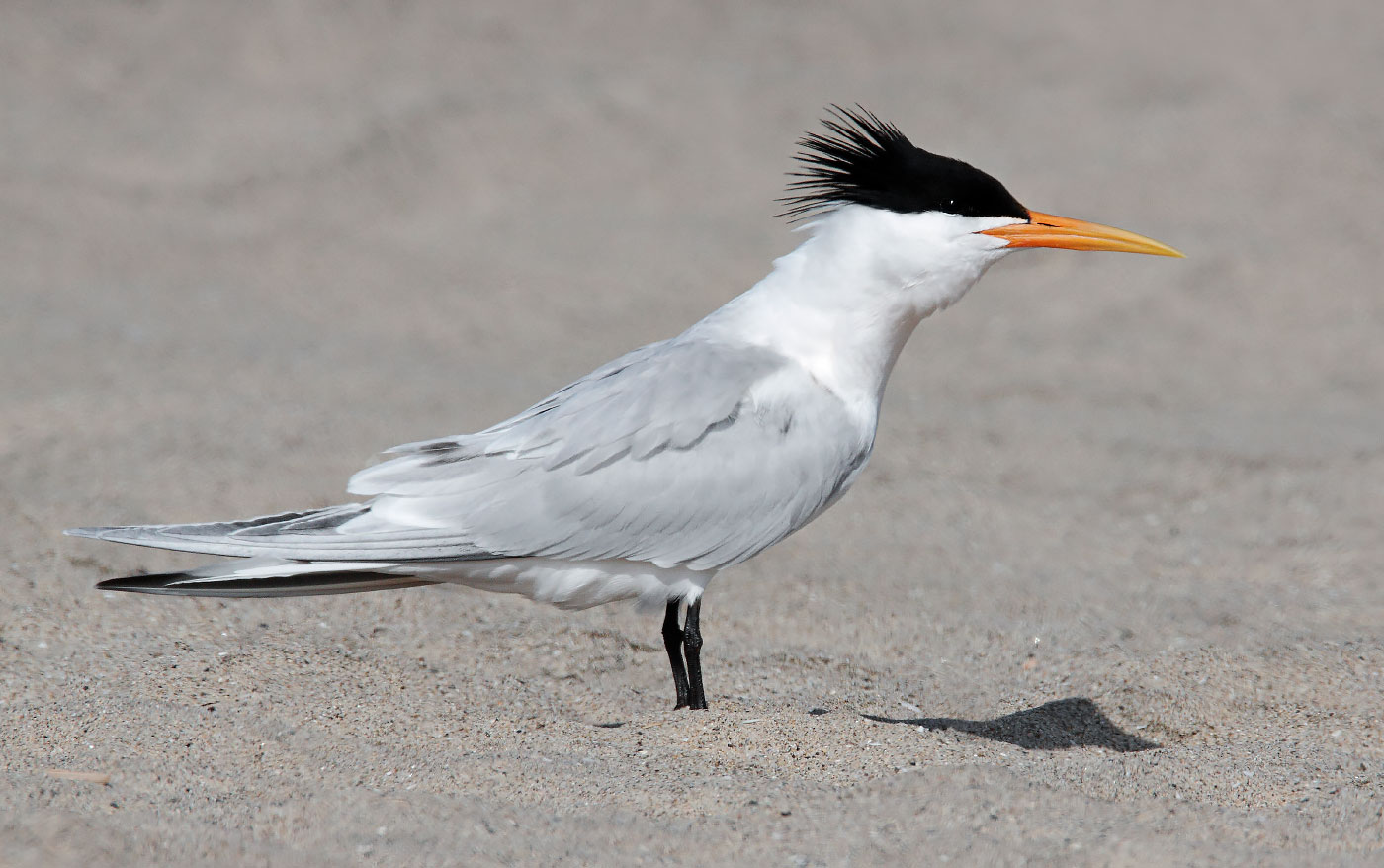
Adult Elegant Tern (California, USA, 8 May 2009). Bill shape and colour can vary considerably between individual Elegant Terns; compare this individual to that shown in image 1. With its yellow-orange bill, this bird recalls Lesser Crested Tern. However, it shows a distinctive contrast between the deeper basal colour and the paler tip. In addition, the shape of the bill is also typical, as it tapers towards the tip, with the position of the gonys, sitting closer to the base of the bill than the tip, creating a drooping impression. The typically long feathers of the crest are obvious (Brian E Small / www.agami.nl).
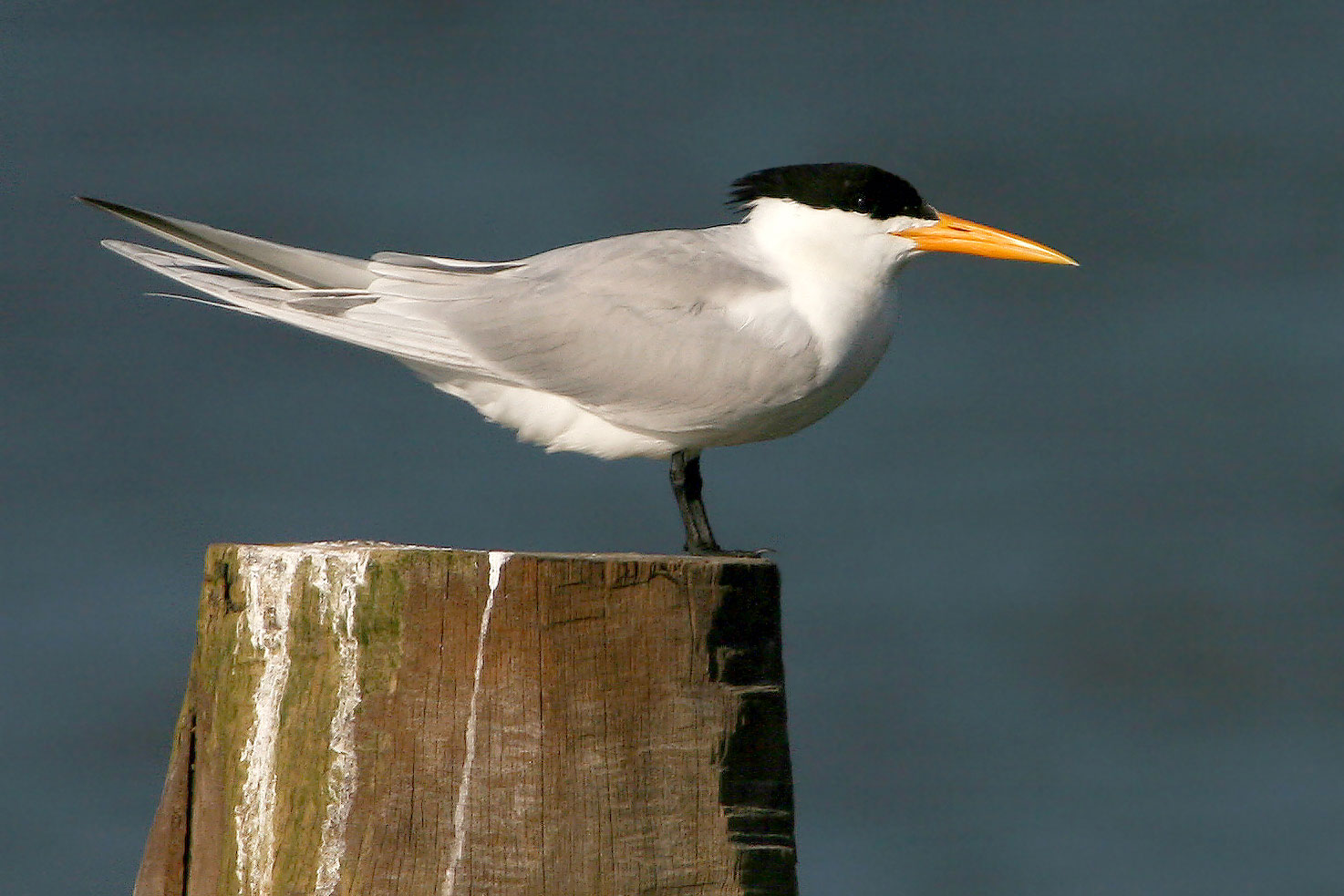
Adult Lesser Crested Tern (Happisburgh, Norfolk, 18 July 2005). Lesser Crested Tern is similar in size to Sandwich Tern. It differs obviously from most Elegant Terns by its bill shape and colour, which is normally thicker at the base, straighter, and with a weak gonydeal angle positioned in the middle of the bill. Its colour is a uniform yellow-orange in breeding plumage, sometimes yellow (especially outside the breeding season), but individuals with the most vividly coloured bills overlap in colour with pale-billed Elegant Terns. On the ground, the mantle is obviously darker than in Sandwich Tern and this should allow the identification of most birds without checking the rump colour (Kit Day).
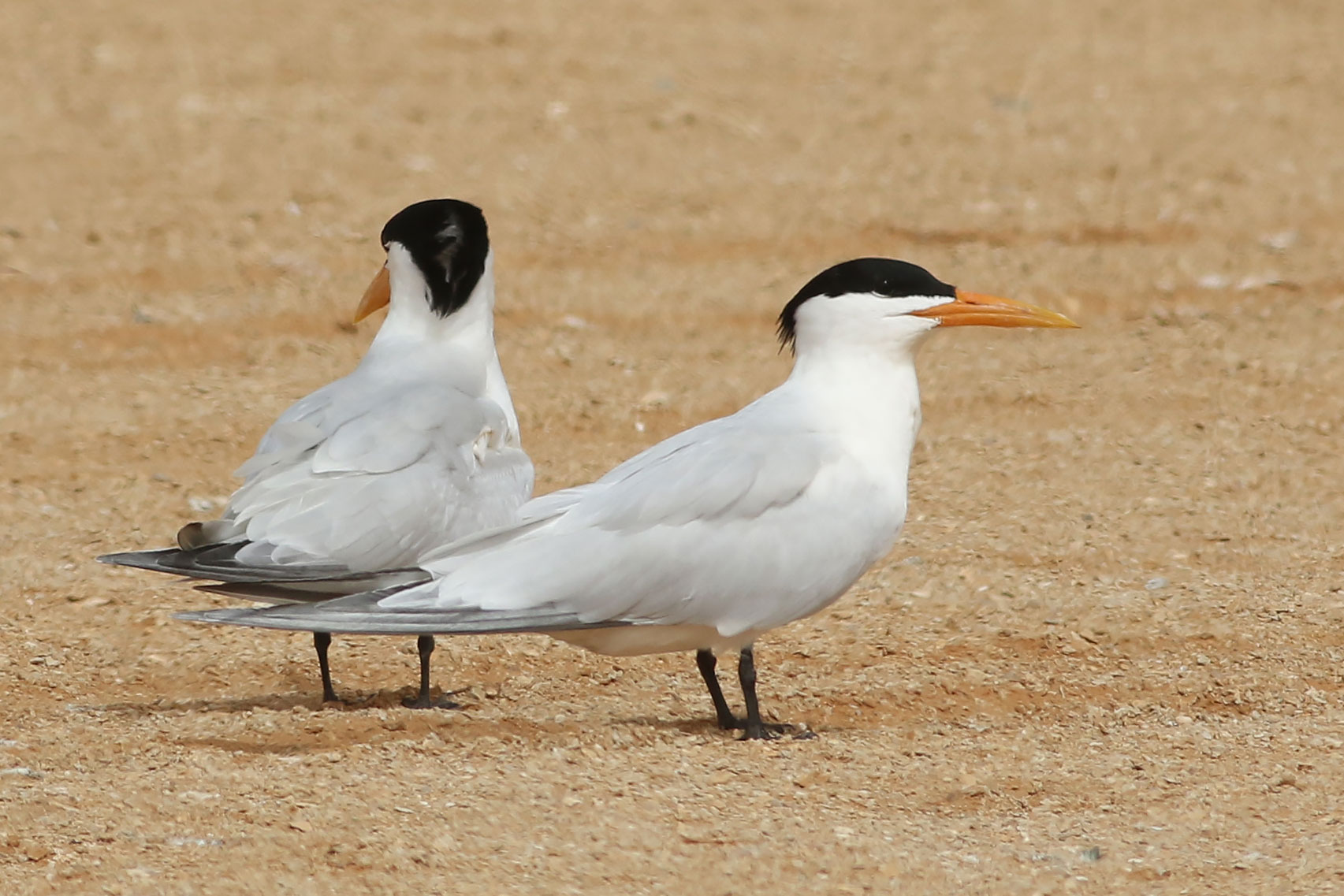
Adult West African Crested Tern (Dakhla, Western Sahara, 28 March 2018). This species is larger – being between Lesser Crested and Caspian Terns in size – and possesses a heavier bill than both Elegant and Lesser Crested. However, a lone West African Crested can be confusingly similar to Lesser Crested or Royal Tern. This bird is relatively easy to tell apart from Royal, with its pale orange bill with a distinct contrast between a deeper basal colour and a paler distal portion. The bill shape is also distinctive, being thinner at the base and, most importantly, with a larger distance between the bill base and nostril compared to Royal (Chris Townend / Wise Birding Holidays).
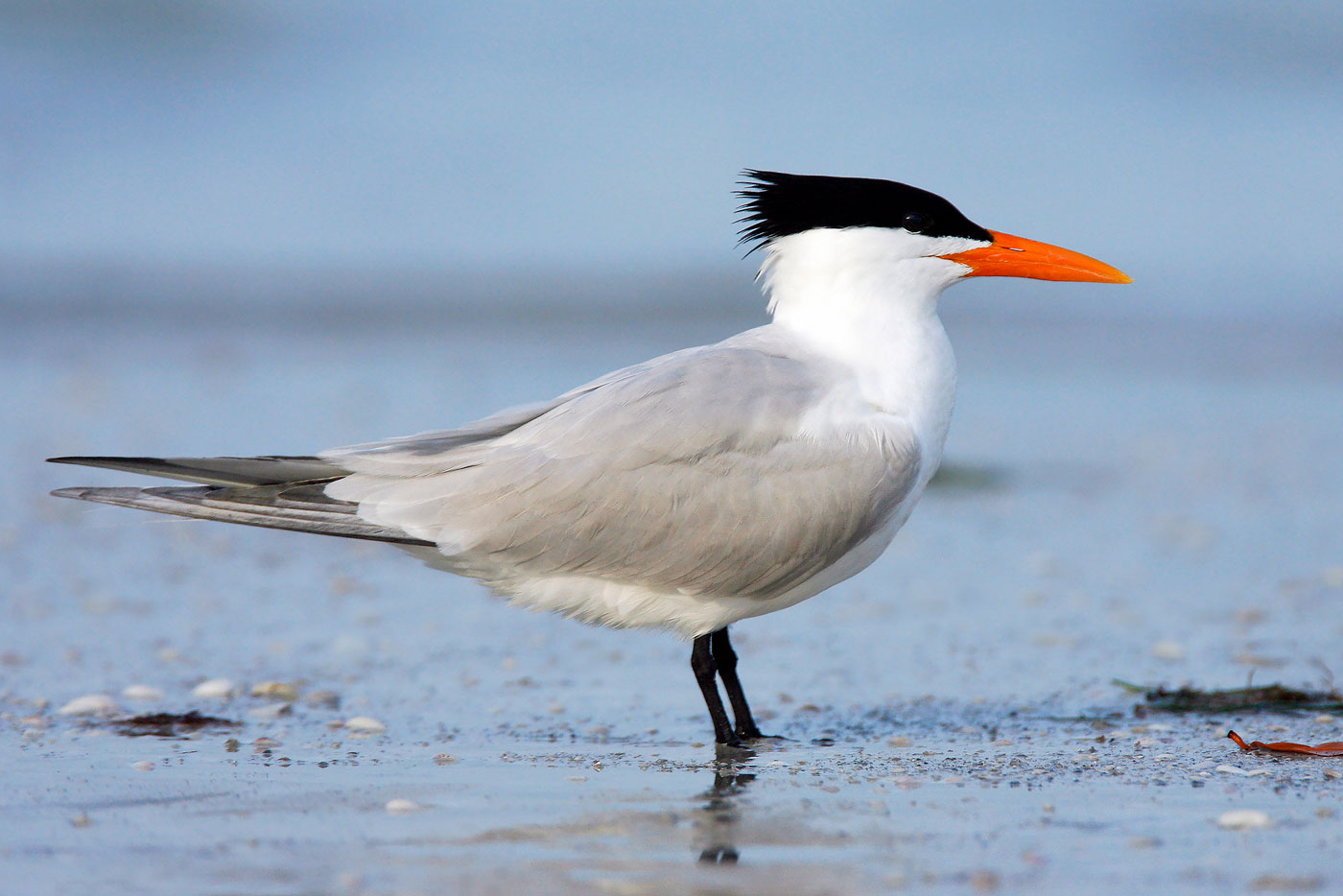
Adult Royal Tern (Florida, USA, 7 April 2007). With its thick, reddish bill, this Royal Tern recalls Caspian Tern more than West African Crested. A typical Royal is larger with a more robust structure than West African Crested, a proportionally thicker bill, with a weaker gonydeal angle positioned further along the bill. The position of the nostril closer to the bill base is another important feature, but requires good-quality photos. The bill colour is often more uniform and redder, but never uniform yellow in adults (Brian E Small / www.agami.nl).
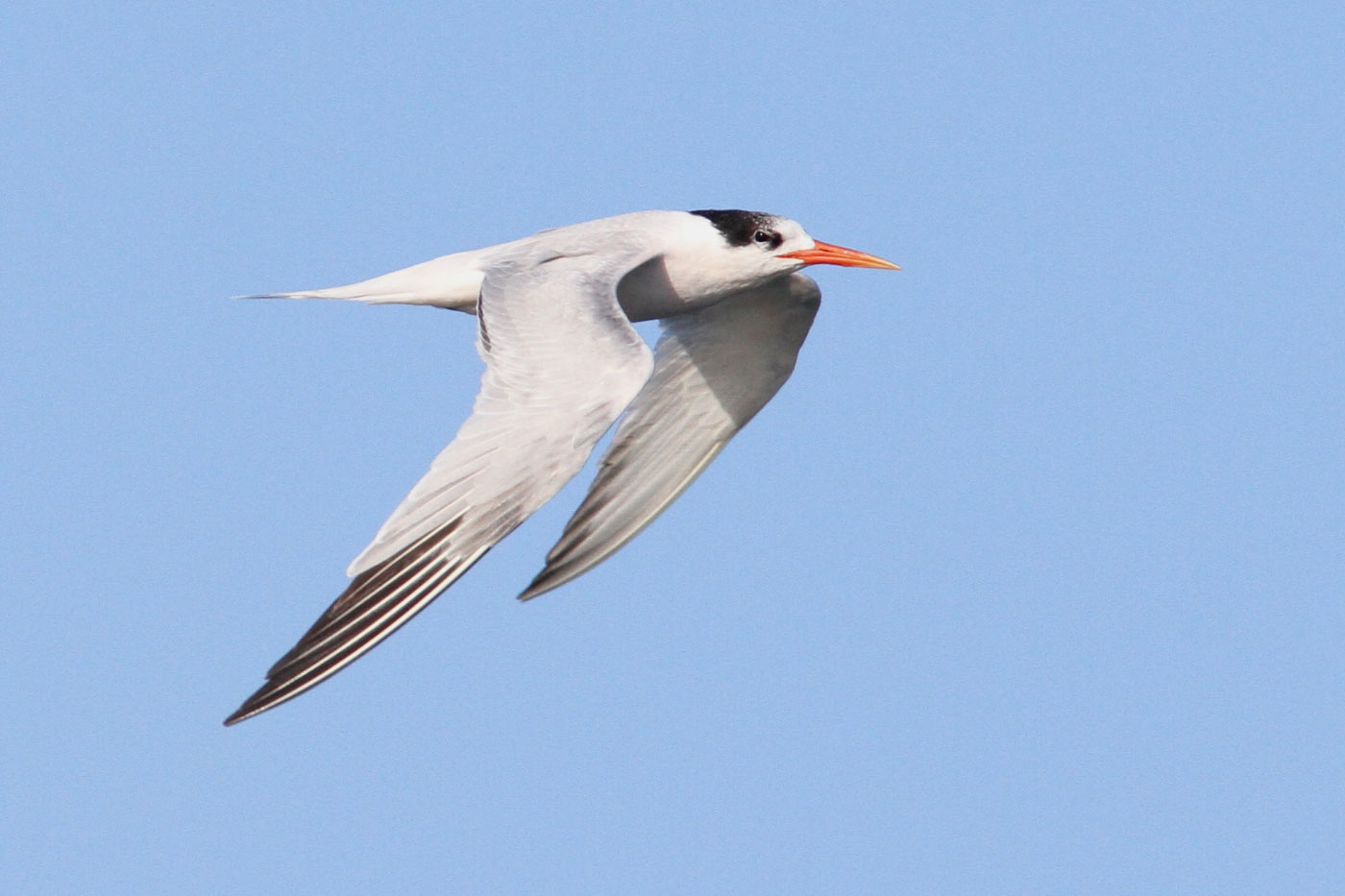
Non-breeding adult Elegant Tern (California, USA, 1 October 2016). All orange-billed terns lose their black cap outside the breeding season and exhibit a black mask. In Elegant Tern, the mask diffusively merges with the white forehead, it is also broader than in the other species and more continuous from the front of the eye to the nape. The combination of a long, thin, reddish bill with a white rump is also diagnostic of Elegant Tern (Sean Fitzgerald).
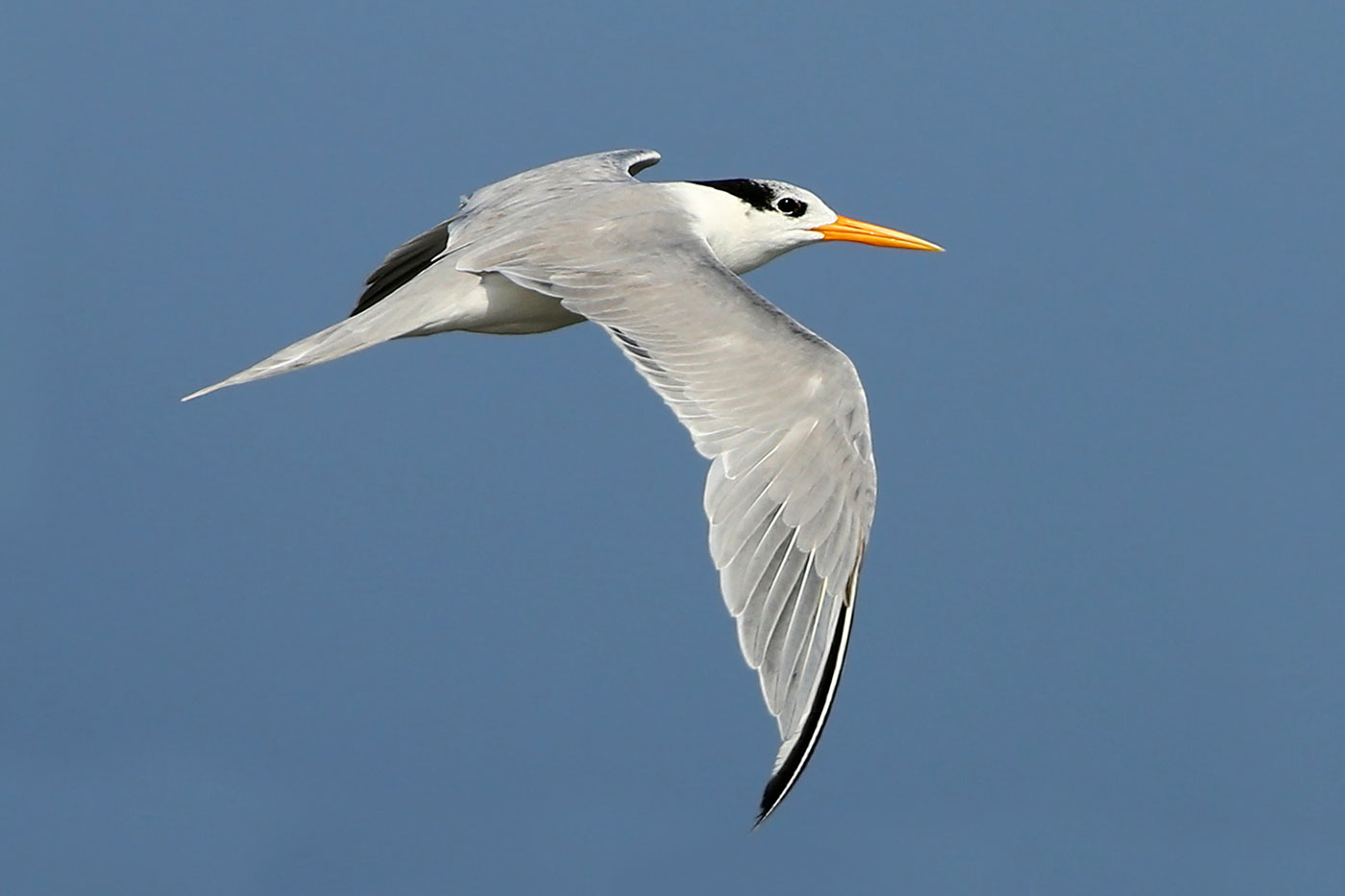
Non-breeding adult Lesser Crested Tern (Al-Seeb, Oman, 3 November 2015). This non-breeding individual could easily be mistaken for an Elegant Tern with a short and pale bill on the ground, but in flight the grey rump is diagnostic. Unlike most Elegant Terns, though, the bill is a uniform yellow-orange colour and the mask is often narrower and interrupted behind the eye. Note that Mediterranean birds, which are more likely to turn up in Europe, often look paler on the upperparts (Aurélien Audevard).
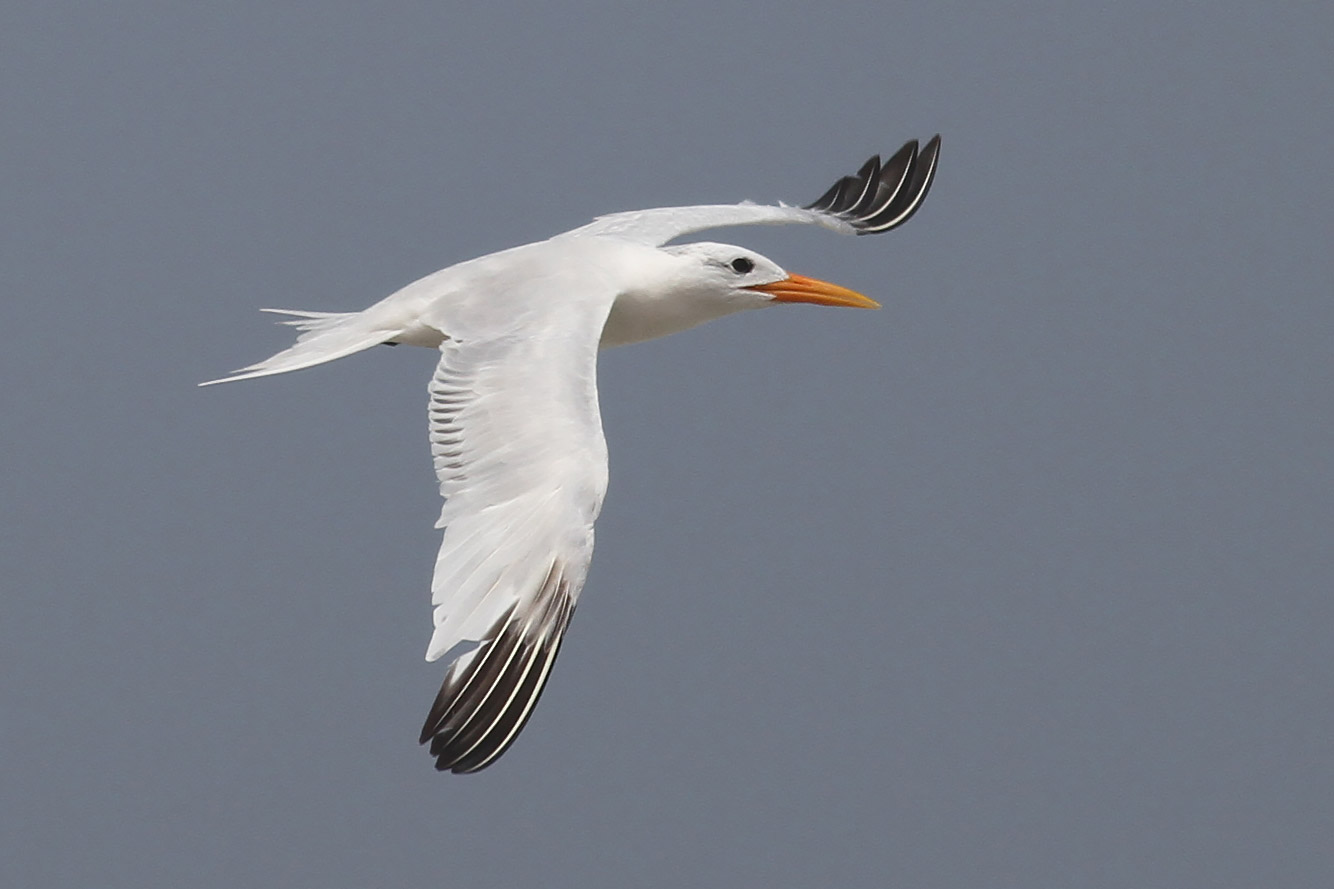
Non-breeding adult West African Crested Tern (Akhfennir, Morocco, 8 September 2019). Immediately after the breeding season, this species can exhibit an almost completely white head, as in this bird. Further differences from Royal Tern include the very pale grey mantle (often of limited use, though) and the well-marked gonydeal angle. Note that the rump is usually pale grey, sometimes not much paler than the mantle (Paul Dufour).
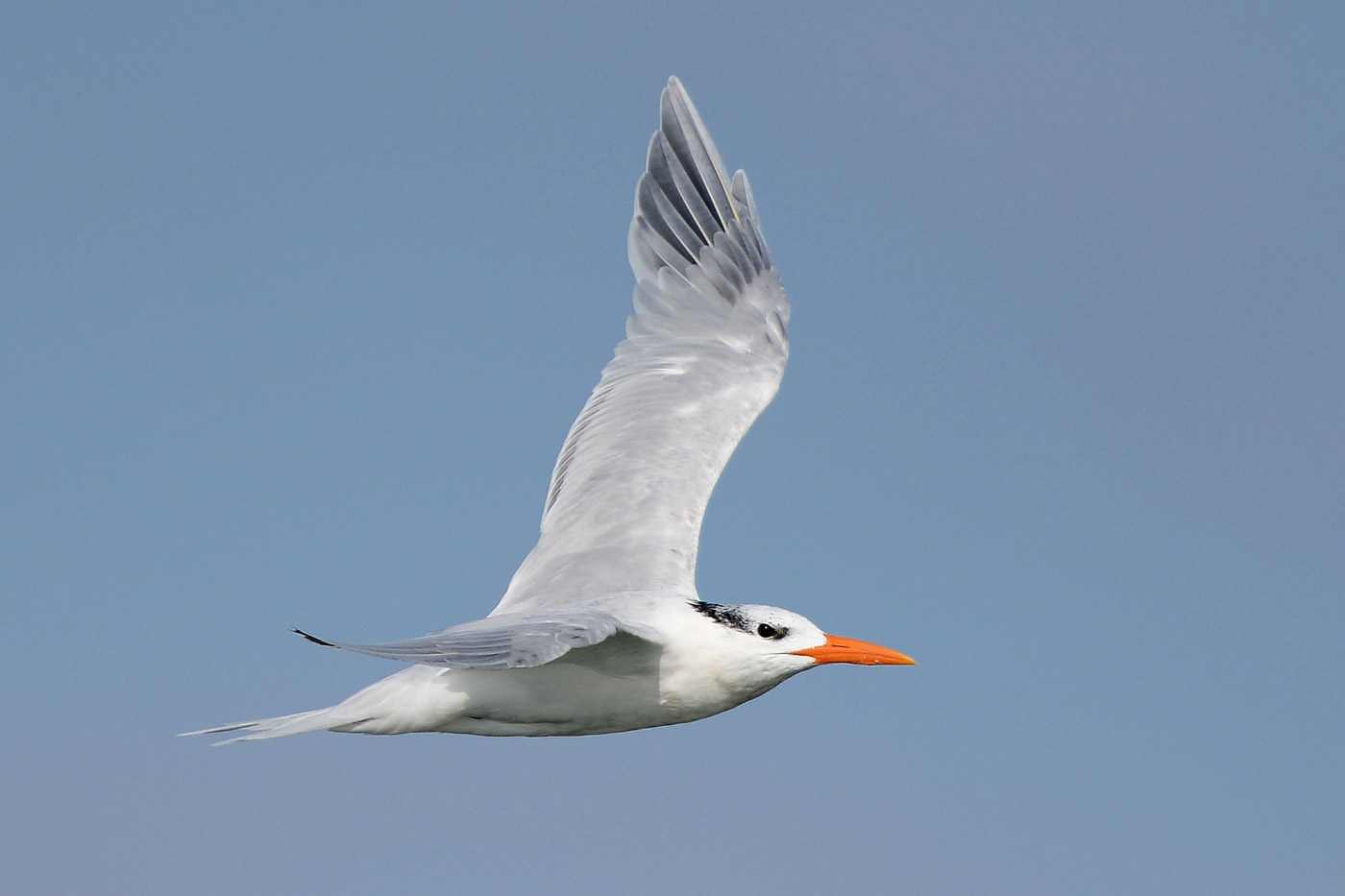
Non-breeding adult Royal Tern (Texas, USA, 14 November 2016). This is a typical non-breeding Royal Tern, with a thick and uniform-coloured orange bill. Note that dark-tipped tail feathers and the grey secondary bar can develop at all ages in most of the orange-billed tern species (Ray Tipper).

First-winter Elegant Tern (California, USA, 9 September 2007). First-winter birds in all 'crested' terns can easily be aged by the more extensive black mask, with a small notch behind the eye, which is often more diffuse than in adults, a short crest, and – most importantly – tertials, secondaries and often some wing coverts showing clear dark centres. The bill is often not fully grown (reaching full adult size in the second year) and identification may be more difficult. In this individual, the dark reddish-orange bill, which pales towards the tip, is diagnostic of Elegant (Julian Hough).
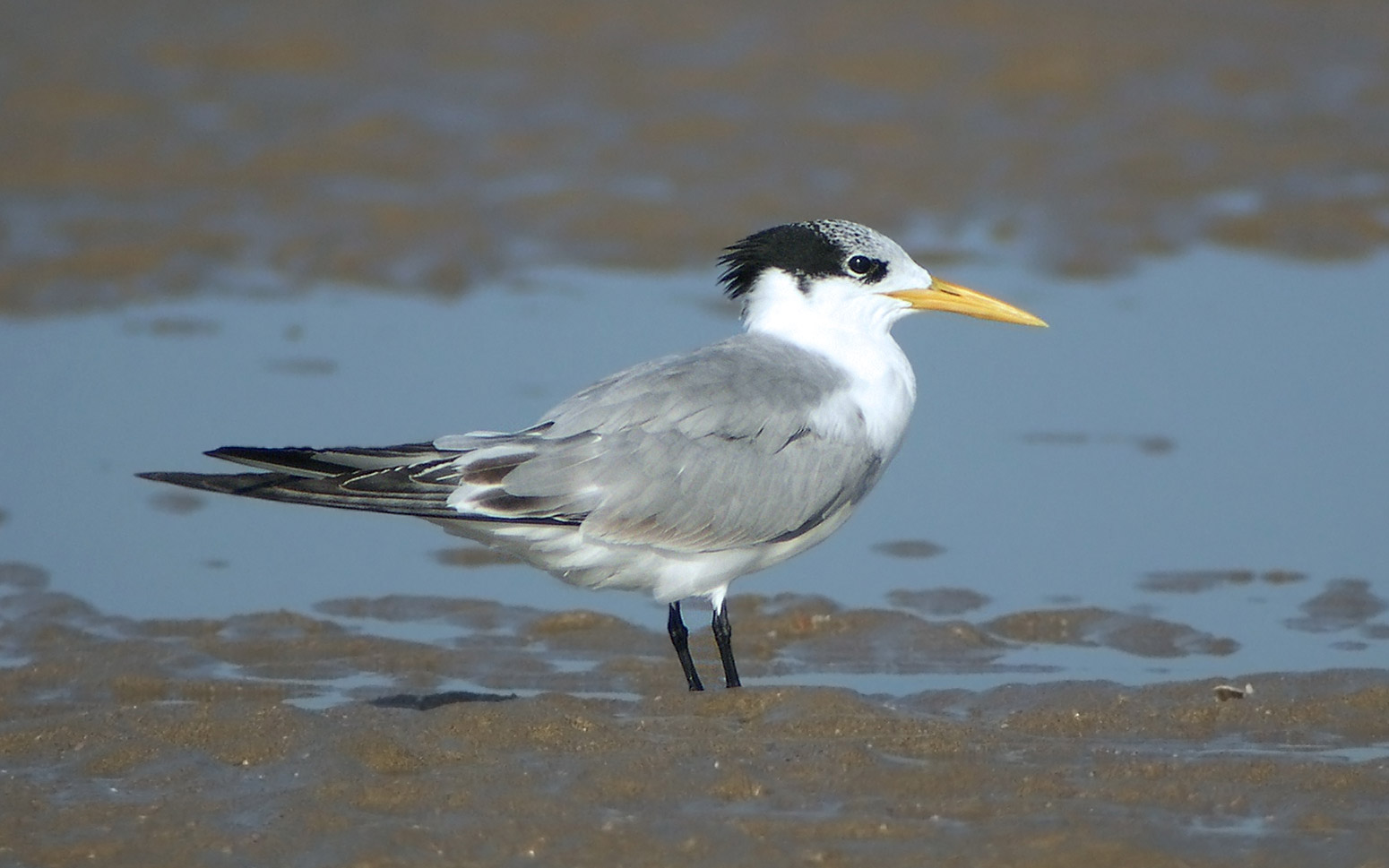
First-winter Lesser Crested Tern (Sur, Oman, 30 October 2004). This is a more advanced first winter, but with clearly visible retained juvenile tertials. The bill is short, narrow and uniformly greenish-yellow, which is diagnostic of Lesser Crested Tern, as are the comparatively dark grey upperparts (Aurélien Audevard).
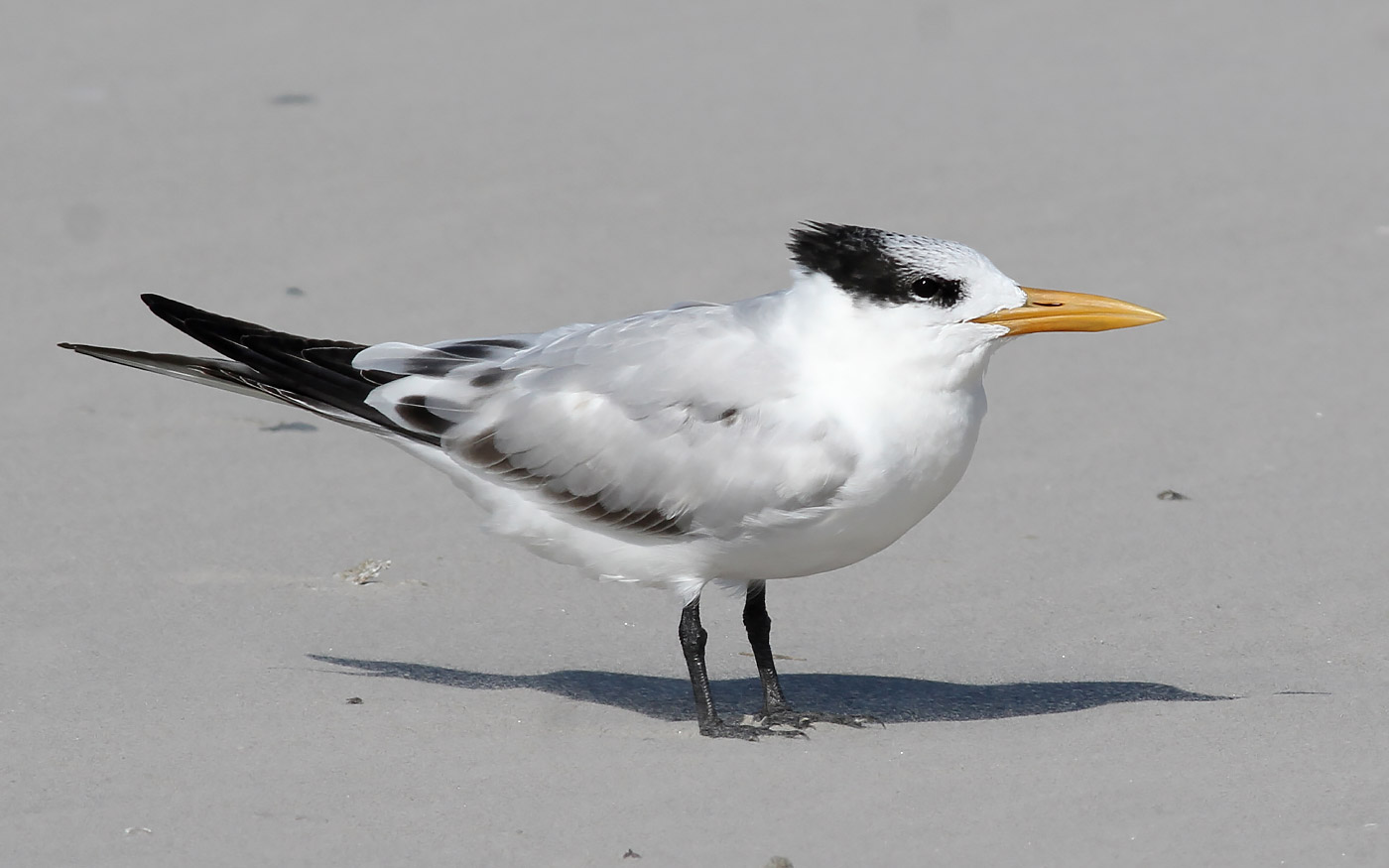
First-winter Royal Tern (New Jersey, USA, 5 October 2011). Even though the rather pale yellow-orange bill colour is reminiscent of West African Crested Tern, the short and very thick shape, with the nostril very close to the bill base, are diagnostic of Royal Tern. The tertials are second generation – very fresh with broad white edges. Such second-generation tertials with well-defined dark centres are very rare in the similar African species (Nick Bonomo).
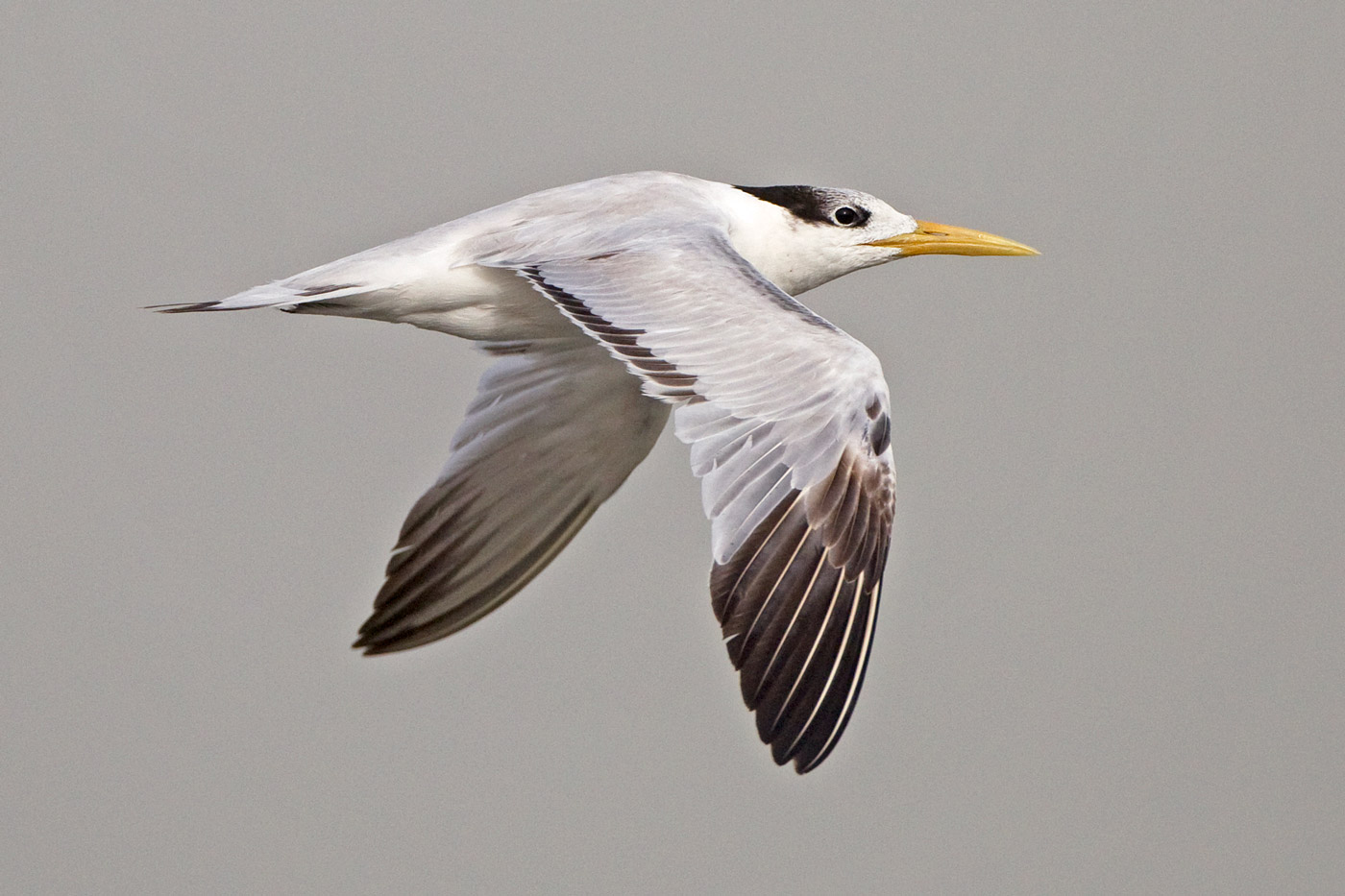
First-winter West African Crested Tern (Tanji, Gambia, 2 March 2012). This bird is easily aged by the retained juvenile secondaries, outer primaries and primary coverts, which are darker than adult feathers. It has already replaced three innermost primaries and the outermost secondary. When compared to the American species, the bill already has a slightly darker base than tip (Robin Chittenden).
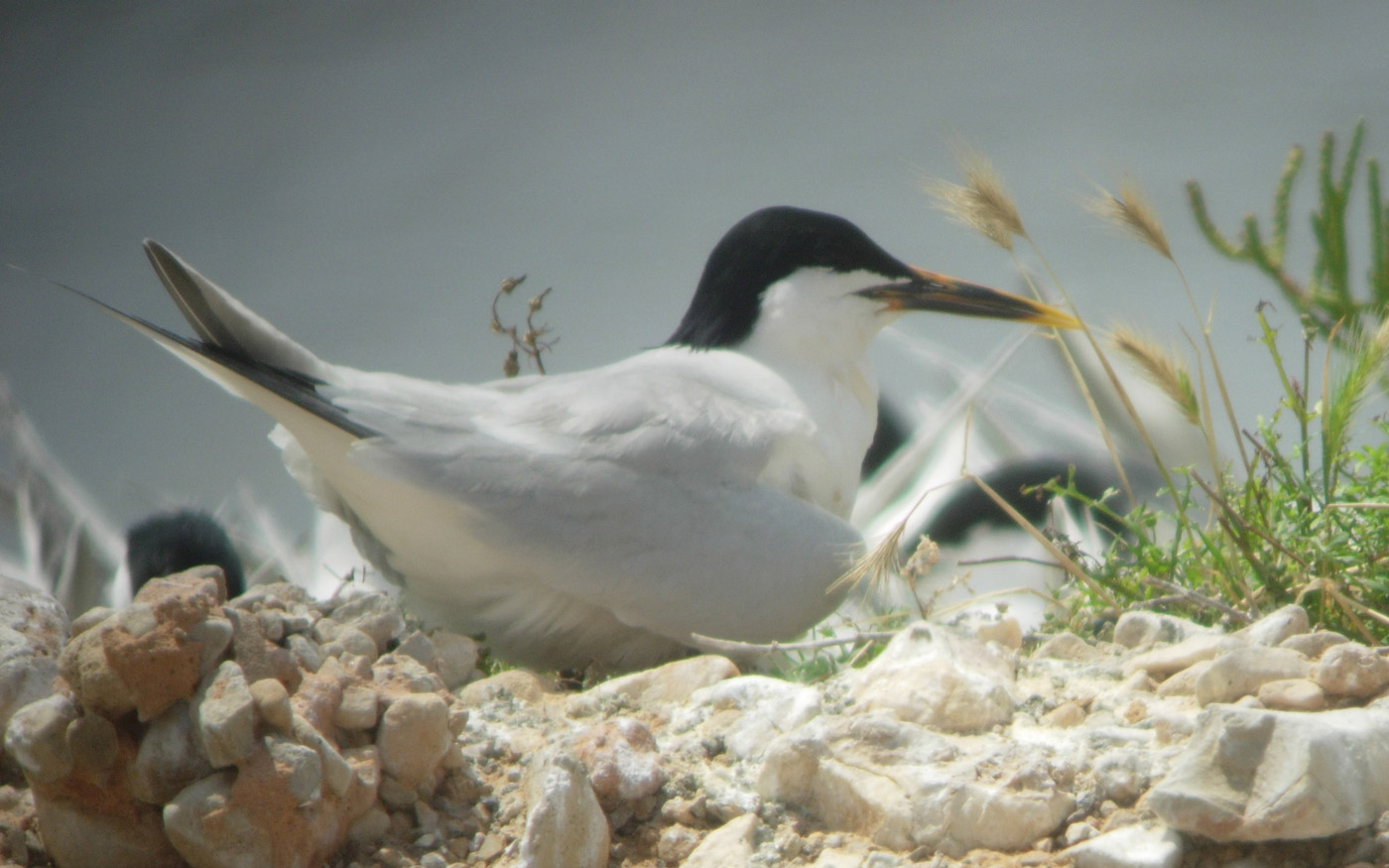
Hybrid Elegant × Sandwich Tern (Ebro Delta, Spain, 23 May 2008). This bird is most probably the chick ringed in 2006 and raised by the mixed Elegant and Sandwich Tern pair in L'Albufera de Valencia. The colour of the bill is the central element in the identification of hybrid orange-billed terns. In the case of Elegant × Sandwich hybrids, the bill often presents a broad, yellowish tip accompanied by yellowish/orange spots distributed randomly on the bill. They are mostly well defined with clear orange-yellow and black borders. The proportion of black and orange-yellow spots may differ between individuals (Ricard Gutiérrez).
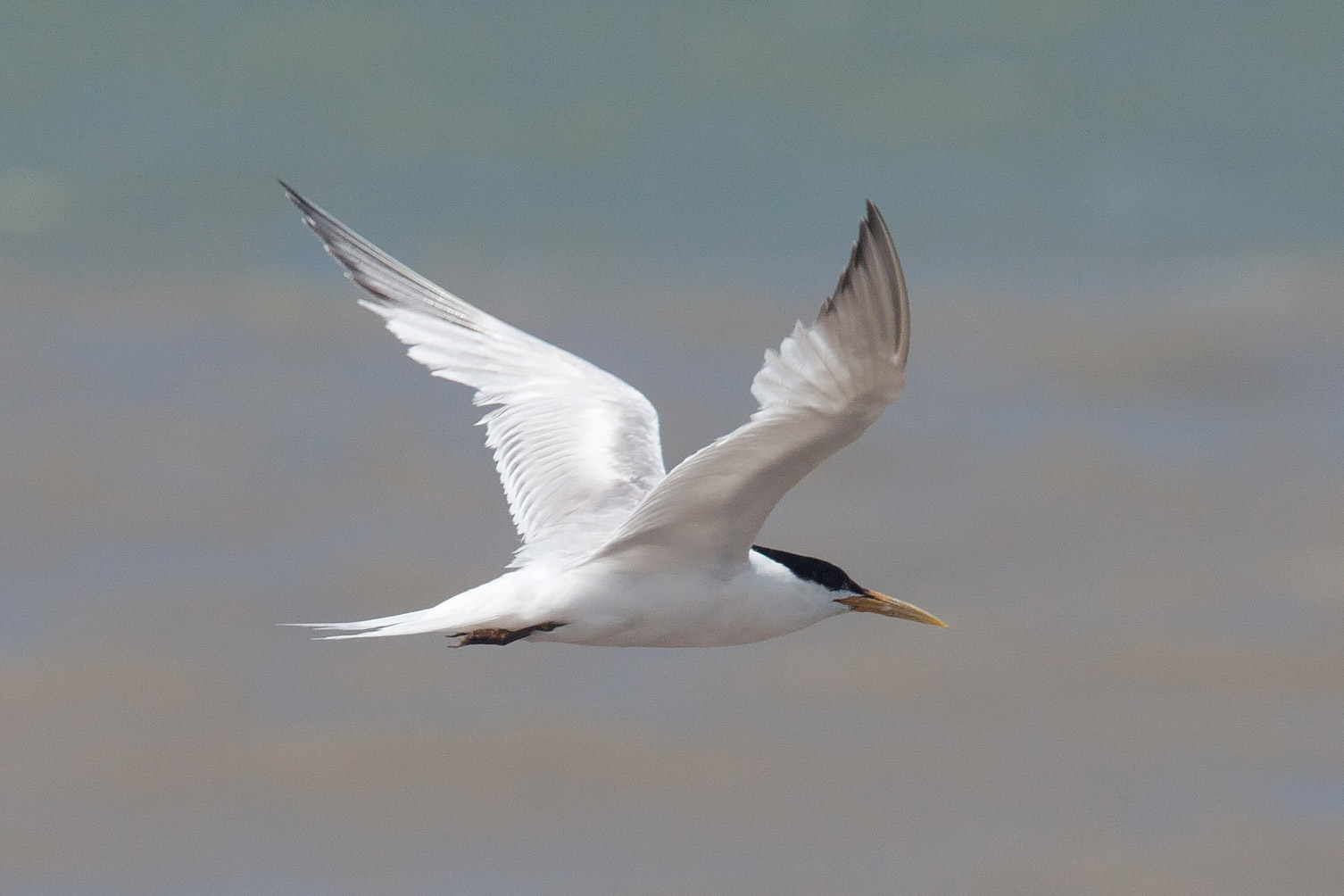
Cayenne Tern (Buenos Aires, Argentina, 22 February 2008). Cayenne Tern, the eurygnathus subspecies of Cabot's Tern Thalasseus acuflavidus, nests on the Atlantic coast of South America and has not yet been definitively observed in Europe. With its white rump, this bird is very similar to an Elegant Tern in flight. Note, however, that the tones of the bill are rather dull compared to most Elegant Terns. This variable and poorly understood taxon requires further study (James Lowen / www.jameslowen.com).
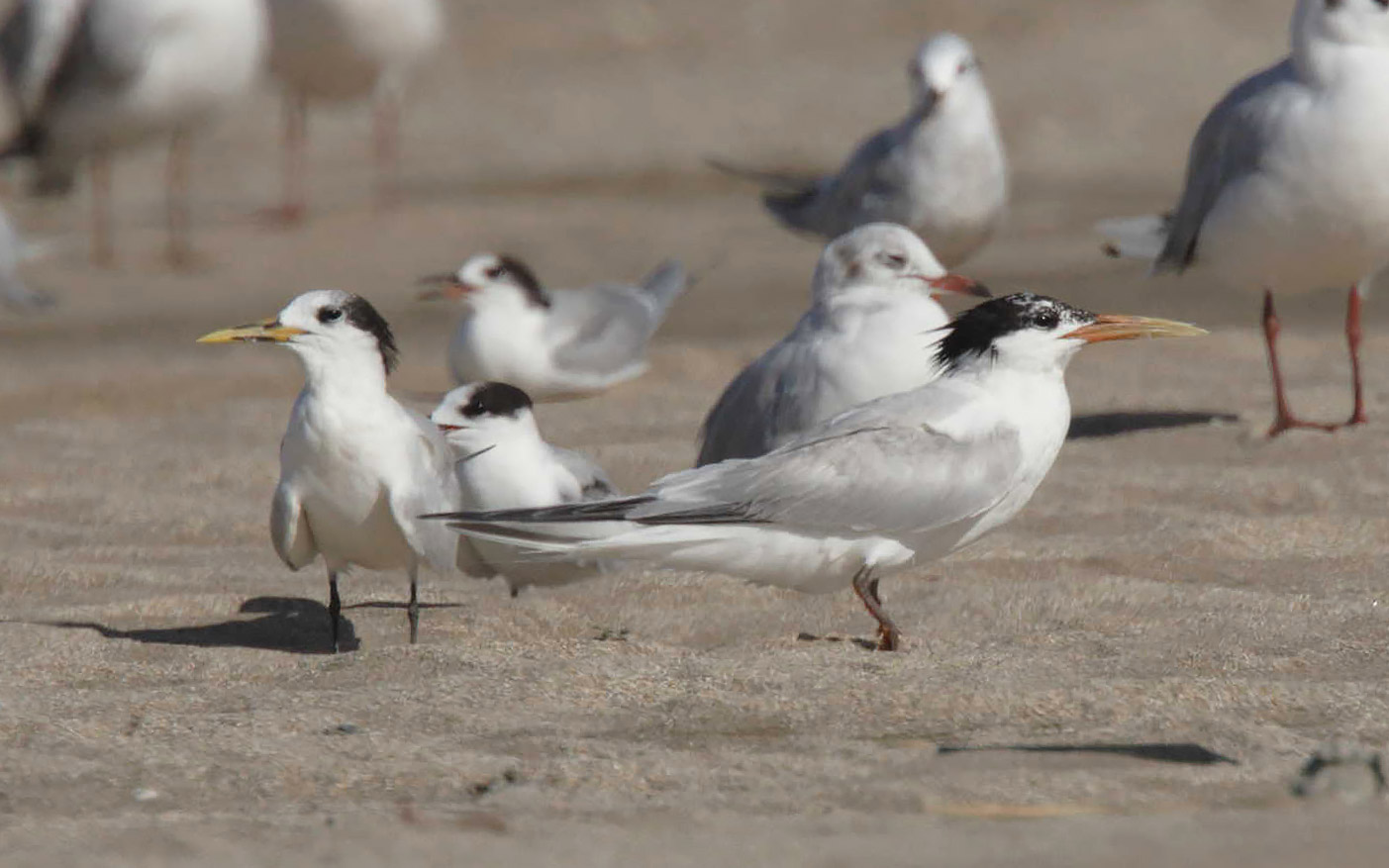
Cayenne Tern (Buenos Aires, Argentina, 22 February 2008). The colour of the bill is variable, ranging from dull greenish-yellow to dull yellow with an orange base. Many show variable dark markings. Those showing dark markings (left bird) can be confused with hybrids, while those with uniform yellow bills (right bird) strongly resemble some Elegant or Lesser Crested Terns. However, the colour is much less vivid than in the latter two species. It should also be noted that the grey of the mantle is slightly darker than that of Elegant Tern and Cayenne is also slightly larger. Due to its Southern Hemisphere distribution, it normally shows a reverse moult pattern compared to birds breeding in the Northern Hemisphere, but vagrants of many species have been shown to adjust their moult timing to their new 'home' (James Lowen / www.jameslowen.com).
References
British Ornithologists' Union Records Committee (BOURC): 49th Report (October 2018). (2018). Ibis 160(4): 936-942.
Clapp, R B, Buckley, P A, and Buckley, F G. (1993). Conservation of temperate North Pacific terns. In The status, ecology, and conservation of marine birds of the North Pacific, edited by Vermeer, K, Briggs, K T, Morgan, K H, and Siegel-Causey, D. 154-162. Ottawa: Can Wildl Serv Spec. Publ.
Collinson, J M, Dufour, P, Hamza, A A, Lawrie, Y, Elliott, M, Barlow, C, and Crochet, P-A. 2017. When morphology is not reflected by molecular phylogeny: the case of three 'orange-billed terns' Thalasseus maximus, Thalasseus bergii and Thalasseus bengalensis (Charadriiformes: Laridae). Biological Journal of the Linnean Society 121: 439-445.
Dies, J I, Chardi, M, and Abad, A. 2019. Elegant Terns breeding at L'Albufera de Valencia, Spain. British Birds 112: 110-117.
Dubois, P J, and Duquet, M. (1991). Letters: Elegant Tern in France. Birding World 4: 125-126.
Dufour, P, Pons, J-M, Collinson, J M, Gernigon, J, Ignacio Dies, J, Sourrouille, P, and Crochet, P-A. (2017). Multilocus barcoding confirms the occurrence of Elegant Terns in Western Europe. Journal of Ornithology 158: 351-361.
Dufour, P, and Crochet, P-A. (2020) Identification of African and American Royal Terns (Sterna albididorsalis and S maxima) based on photographic evidence and sound recordings. Dutch Birding 42: 1-24.
Stoddart, A, and Batty, C. (2019). From the Rarities Committee's files: The Elegant Tern in Britain and Europe. British Birds 112: 99-109.
- This article was originally published in the June 2020 issue of Birdwatch magazine.






